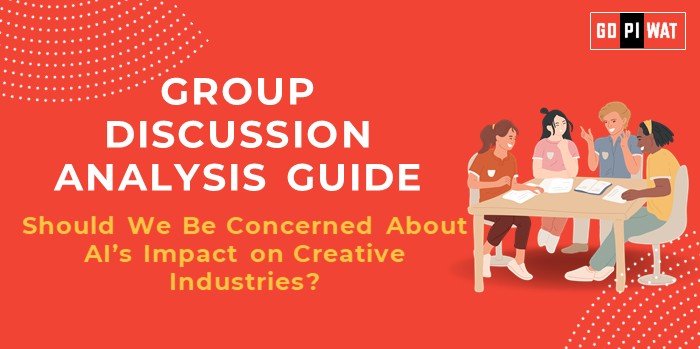📋 Group Discussion (GD) Analysis Guide: Should We Be Concerned About AI’s Impact on Creative Industries?
🌐 Introduction to the Topic
- 💡 Opening Context: Artificial intelligence (AI) is revolutionizing various industries, including the creative sector, raising questions about its potential to augment or displace human creativity.
- 📜 Topic Background: AI applications, such as generative art, music composition, and automated writing, have surged in the last decade. Innovations like OpenAI’s GPT models, MidJourney, and DALL-E have democratized creative tools, yet concerns about job displacement, originality, and ethical boundaries persist.
📊 Quick Facts and Key Statistics
- 🎨 AI Art Market Growth: Valued at $1.6 billion in 2023, projected to grow at 20% CAGR.
- 📉 Jobs at Risk: 30% of creative jobs face automation by 2030, according to the World Economic Forum.
- 💰 Generative AI Revenue: Expected to reach $100 billion by 2025.
- 🚀 Adoption Rate: 60% of creative agencies integrate AI tools in workflows.
- 🤔 Human vs AI Originals: Over 70% of surveyed audiences struggle to differentiate between AI-generated and human-created content.
👥 Stakeholders and Their Roles
- 🎨 Creative Professionals: Adaptation and innovation to integrate AI tools into workflows.
- 💻 AI Developers: Ethical algorithm design and fostering transparency in content creation.
- 🏛️ Policy Makers: Regulating copyright issues and ensuring fair competition.
- 👨👩👦 Consumers: Driving demand for authentic and original content.
- 📚 Industry Organizations: Establishing frameworks for co-existence between AI and human creativity.
🏆 Achievements and Challenges
✨ Achievements
- Efficiency Boost: AI tools reduce design timelines by up to 50%.
- Accessibility: Democratizes art creation for non-specialists.
- Innovation Catalyst: New forms of creative expression emerge, blending AI and human efforts.
⚠️ Challenges
- Job Displacement: Artists and writers face potential redundancy.
- Ethical Concerns: Originality and copyright infringement issues proliferate.
- Bias: AI creativity often reflects societal stereotypes.
🌍 Global Comparisons
- 🇪🇪 Estonia: Integrates AI tools while preserving artist incentives.
- 🇨🇳 China: Rapid adoption with limited copyright protections.
📚 Structured Arguments for Discussion
- 💪 Supporting Stance: “AI enhances creative industries by improving efficiency and expanding possibilities for non-experts.”
- ❌ Opposing Stance: “AI threatens creative professions by displacing jobs and diminishing originality.”
- ⚖️ Balanced Perspective: “While AI poses challenges to creative industries, collaboration between humans and AI can lead to innovative synergies.”
💡 Effective Discussion Approaches
- 📊 Opening Approaches:
- “With 60% of creative agencies already using AI tools, is this the future or a threat to human creativity?”
- “Imagine a world where every art piece or song you enjoy is algorithmically generated. How does that impact human value in art?”
- 🎯 Counter-Argument Handling:
- “AI cannot replace human emotion and context, vital in meaningful creativity.”
- “Collaboration between human artists and AI tools can amplify, not replace, creative expression.”
🔍 Strategic Analysis of Strengths and Weaknesses
- ✅ Strengths: Speed and efficiency in content production, increased access to creative tools for amateurs.
- ❌ Weaknesses: Loss of traditional craft jobs, limited emotional resonance in AI creations.
- 🚀 Opportunities: AI-human collaboration to create novel art forms, emerging jobs in AI ethics and creative algorithm development.
- ⚠️ Threats: Monopolization by tech giants, plagiarism, and legal ambiguities.
🎓 Connecting with B-School Applications
- 📌 Real-World Applications: AI in marketing content creation, product design, and customer engagement.
- ❓ Sample Interview Questions:
- “How can businesses leverage AI for creative campaigns while maintaining originality?”
- “What policies should regulate AI’s role in the arts?”
- 📘 Insights for B-School Students:
- AI opens opportunities for strategic partnerships.
- Emerging roles demand balancing innovation with ethical considerations.


